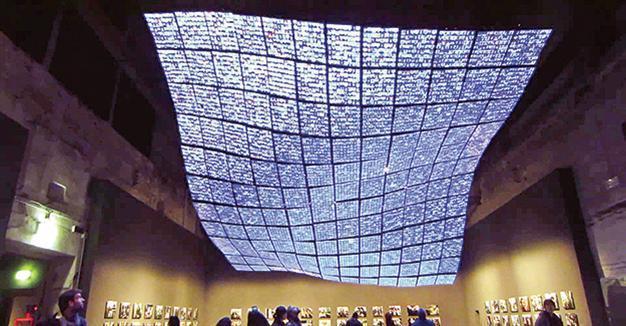Sakıp Sabancı portrait represents Turkey
LONDON – Doğan News Agency
 “The Portrait of Sakıp Sabancı,” created by artist Kutluğ Ataman using 10,000 LCD screens, is on display at one of the most prestigious museums in the world, London’s Royal Academy of Arts.
“The Portrait of Sakıp Sabancı,” created by artist Kutluğ Ataman using 10,000 LCD screens, is on display at one of the most prestigious museums in the world, London’s Royal Academy of Arts. Speaking about the story of the Sabancı portrait, Sabancı Holding CEO Zafer Kurtul said it was created with portrait photos of 10,000 volunteers and that the artwork represented Turkey.
He said that they wanted such a work created for the 10th anniversary of the death of businessman Sabancı, and commissioned world-famous Turkish artist Ataman to make it.
He also said the portrait was first displayed at the Sakıp Sabancı Museum and then received an invitation from the Venice Biennial.
“Now it is on display at the Royal Academy of Arts in London. Sakıp Sabancı was a commercial genius. Every genius is inspired by a source. Sabancı’s source was to serve the country, to serve the society and contribution to art. This artwork symbolizes working together and democracy. We brought together the photos of 10,000 of our workers. Actually, it represents our country,” Kurtul said.
Kurtul said the artwork was an innovative one, adding that the photos of 10,000 blue- and white-collar workers of Sabancı Holding were displayed together with the photos of the Sabancı family members.
“There is an absolute equality here. This is very important to us as it shows unity, democracy and what can be succeeded together,” he said.
Kurtul said after its display in a summer exhibition in London, the work would return to Turkey, adding, “I advise you to see it. It is not possible to explain it. It is necessary to experience this feeling.”
Display at Summer Exhibition
Ataman’s monumental video installation “The Portrait of Sakıp Sabancı” was invited to be exhibited at the Royal Academy of Arts London Summer Exhibition 2016.
Commissioned by the Sakıp Sabancı family in 2011 for the 10th anniversary of his passing, the work emphasizes Sabancı’s contribution to the development of technology in Turkey, resulting in a monumental work of art consisting of approximately 10,000 LCD panels where the raw material is, as a whole, human.
The work, which was previously exhibited at the Sakıp Sabancı Museum in 2014 and at the 56th Venice Biennale in 2015, will be at the Royal Academy of Arts until Aug. 21.
Organized this year for the 248th time without interruption, the Summer Exhibition is curated by leading British sculptor Richard Wilson and informs the world of global contemporary art by bringing together the works of approximately 1,000 artists within the halls of the Royal Academy of Arts.
Since its inception in 1769, the Summer Exhibition at the Royal Academy of Arts has constituted a stimulating and lively exhibition venue, presenting artists from all around the world to exhibit their works in an international platform.
















